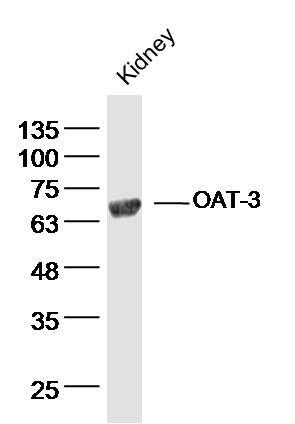Shopping Cart
Remove All Your shopping cart is currently empty
Your shopping cart is currently empty
Anti-OAT-3 Polyclonal Antibody is a Rabbit antibody targeting OAT-3. Anti-OAT-3 Polyclonal Antibody can be used in WB.
| Pack Size | Price | USA Warehouse | Global Warehouse | Quantity |
|---|---|---|---|---|
| 50 μL | $221 | 7-10 days | 7-10 days | |
| 100 μL | $374 | 7-10 days | 7-10 days | |
| 200 μL | $528 | 7-10 days | 7-10 days |
| Description | Anti-OAT-3 Polyclonal Antibody is a Rabbit antibody targeting OAT-3. Anti-OAT-3 Polyclonal Antibody can be used in WB. |
| Synonyms | Solute carrier family 22 member 8, SLC22A8, S22A8_RAT, Organic anion transporter 3, OAT3, hOAT3 |
| Ig Type | IgG |
| Reactivity | Mouse (predicted:Human,Rat,Rabbit) |
| Verified Activity | Sample: Kidney (Mouse) Lysate at 40 μg Primary: Anti-OAT-3 (TMAB-01279) at 1/300 dilution Secondary: IRDye800CW Goat Anti-Rabbit IgG at 1/20000 dilution Predicted band size: 59 kDa Observed band size: 65 kDa  |
| Application | |
| Recommended Dose | WB: 1:500-2000 |
| Antibody Type | Polyclonal |
| Host Species | Rabbit |
| Subcellular Localization | Basolateral cell membrane; Multi-pass membrane protein (Potential). Note=Localizes on the brush border membrane of the choroid epithelial cells. Localizes to the basolateral membrane of the proximal tubular cells. Localizes on the abluminal and possibly, luminal membrane of the brain capillary endothelial cells (BCEC) (By similarity). |
| Tissue Specificity | Expressed in kidney. |
| Construction | Polyclonal Antibody |
| Purification | Protein A purified |
| Appearance | Liquid |
| Formulation | 0.01M TBS (pH7.4) with 1% BSA, 0.02% Proclin300 and 50% Glycerol. |
| Concentration | 1 mg/mL |
| Research Background | Human organic anion transporter (OAT) 3 (SLC22A8) is localized to the basolateral membranes of renal tubular epithelial cells and plays a critical role in the excretion of anionic compounds. Recent advances in molecular biology have identified three organic anion transporter families: the organic anion transporter (OAT) family encoded by SLC22A, the organic anion transporting peptide (OATP) family encoded by SLC21A (SLCO), and the multidrug resistance-associated protein (MRP) family encoded by ABCC. These families play critical roles in the transepithelial transport of organic anions in the kidneys as well as in other tissues such as the liver and brain. Among these families, the OAT family plays the central role in renal organic anion transport. Knowledge of these three families at the molecular level, such as substrate selectivity, tissue distribution, and gene localization, is rapidly increasing. |
| Immunogen | KLH conjugated synthetic peptide: rat OAT-3 |
| Antigen Species | Rat |
| Gene Name | SLC22A8 |
| Protein Name | Solute carrier family 22 member 8 |
| Biology Area | Channels,Drug metabolism,Drug metabolism |
| Function | Plays an important role in the excretion/detoxification of endogenous and exogenous organic anions, especially from the brain and kidney. Involved in the transport basolateral of steviol, fexofenadine. Transports benzylpenicillin (PCG), estrone-3-sulfate (E1S), cimetidine (CMD), 2,4-dichloro-phenoxyacetate (2,4-D), p-amino-hippurate (PAH), acyclovir (ACV) and ochratoxin (OTA). |
| Molecular Weight | Theoretical: 59 kDa. |
| Stability & Storage | Store at -20°C or -80°C for 12 months. Avoid repeated freeze-thaw cycles. |
| Transport | Shipping with blue ice. |
| Size | Quantity | Unit Price | Amount | Operation |
|---|

Copyright © 2015-2026 TargetMol Chemicals Inc. All Rights Reserved.